Indonesia
If you have had enough of Europe on your travel list, and your soul is calling for unusual experiences, there is nothing better than embarking on a trip to Asian countries. You will spot so many exotic things there, as far as the eye can see.
Indonesia is one of the most visited destinations. It is the land of a myriad of islands, most of which do not even have names. Here, the brilliance of luxurious hotels and business centres comes together with the horrifying poverty of the slums. And the local beaches stun every visitor with their majestic beauty.

General Information
This world’s most populous country is also considered the largest island country with a population of more than 275 million people. It includes around 18,000 volcanic islands of the Malay Archipelago and a part of New Guinea.
Indonesia is a presidential republic. Its capital is Jakarta, a city on the island of Java populated by 10 million people of different ethnicities.
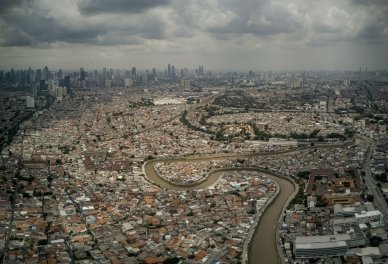
Jakarta, the capital of Indonesia
Historical Background
As a republic, Indonesia appeared on the map of the world after World War II in 1945, when it gained independence.
Before that, the country had been a Dutch colony between the 17th and the beginning of the 20th century. During World War II, it fell under Japanese occupation.
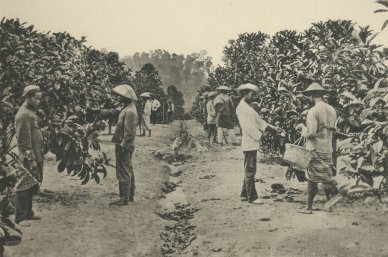
Workers harvest crops on a plantation in the Dutch East Indies
However, the Netherlands did not agree on the sovereignty of its former colony for a long time. So it used to send its military forces to the islands, thus ignoring the terms and conditions of the Renville Agreement, a signatory to which the country was.
There were times when the United States of Indonesia existed within the Indonesian territory. That quasi-state comprised several islands and was supported by its former sovereign rulers — the Dutch.
It was August 1950 when everything worked out. Most of the states acceded to the newly formed republic — Indonesia. In November of the same year, the formation of a unitary state finished. The Dutch controlled only a small part of New Guinea.
All those dramatic events took place during the presidency of the first leader Sukarno, an ambitious man who aspired to total power.
He managed to gain it to some extent, though. He usurped the authority and led the country through a socialist path, trying to establish connections with the USSR.
Nonetheless, in 1965, the internal political and economic crises reached their peaks. The military forces under the command of General Suharto gave rise to a purge and made the President relinquish his powers along with the socialist model of the country’s development. The Communist Party was banned, and its adherents were subjected to persecution and terror. For a couple of years, Suharto’s dictatorship eliminated more than two million communist followers.
The military forces did change economic and political development into the capitalist direction and therefore initiated the rapprochement with the USA and other western countries.
Multi-billion investments started flowing to Indonesia. The national economy acquired unprecedented opportunities for further development. The standard of living increased, and the country was becoming more and more influential in southeastern Asia.

Indonesia's capital Jakarta in 1985
Indonesia existed under the rule of Suharto till the end of the 1990s. It could have existed even longer in those conditions, but in 1997-1998, there precipitated a severe economic crisis. It hit the country hard: the unemployment rate increased, and the standard of living fell.
Suharto’s opponents were quick to jump at a chance.
For a decade, the country underwent nasty shocks that stemmed from constant changes of the national leaders and followed up the political scandals. It was 2009 when stability and economic improvement finally emerged.
Indonesia is a developed country now, where predominantly agriculture, industry, and tourism generate the budget. The state controls a considerable part of the economy.
The standard of living in Indonesia is not homogeneous. Only 10% of its citizens have a high income; the other 10% - 15% live below the poverty line, spending less than $2 a day. The rest of the population keeps the balance between poverty and an adequate living standard.
Climate and Geography
Indonesia is an island country located between the Pacific and Indian Oceans. It has terrestrial boundaries with Malaysia, New Guinea, and East Timor.
The republic consists of around 1,800 islands, but nobody knows the exact number because they are too small, uninhabited, and unnamed.
The largest Indonesian islands are Java, Sumatra, Bali, Borneo, and Sulawesi. They are well-known due to a high level of economic and tourism development.
The climate is equatorial with high humidity and two seasons — a wet season and a dry season. The first one lasts from November to March or April and is not the best time for trips. The period from May to October is dry and hot.
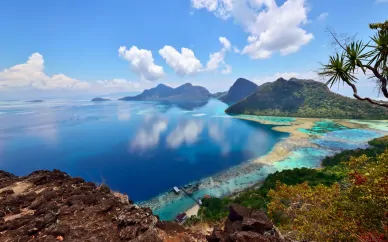
Borneo, Indonesia
Language, Religion, and Currency
A multitude of ethnicities inhabits this populous country. They speak 700 languages, but Indonesian is the official.
Indonesia is the largest Muslim country: 90% of its population is adherent to Islam.
The official currency is the Indonesian rupiah.
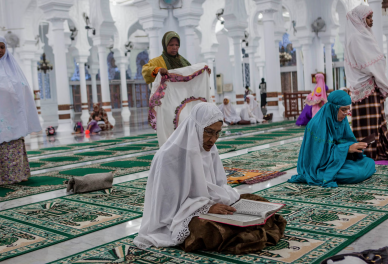
Mosque in Indonesia
Directions
The best way of getting to Indonesia is air travel. There are no direct flights from the Americas and most European countries, and transit will be required. No problem will constitute the flight from the Middle East, Indonesia’s neighbouring countries, and Australia.
The options for travelling to Indonesia by sea include a ferry, a cruise ship, or a yacht. Ferries depart from Singapore, Malaysia, and the Phillippines. Cruise ship ports are in North Jakarta, Surabaya, and Bali.
You may also travel to Indonesia by bus if you are either in Timor, Malaysia, and Papua New Guinea.

Accommodation
Once in Indonesia, you may opt for a hotel, a bungalow, a villa, a motel, or a guest house to stay for a short or a long period.
Each of the places mentioned above has its designation, advantages, and disadvantages. The easiest and most evident option for those whose trip has been arranged by a travel agency is a hotel room. Large families or groups of people will prefer bungalows or villas due to the much space.
- Royal Safari Garden Resort & Convention is a four-star hotel in Cisarua, Western Java. Each room has a living room and a bathroom, and comfortable double beds. Free breakfast and Wi-Fi.
- AMNAYA Resort Kuta is a four-star hotel in Kuta, Bali. Each room has a balcony, air-conditioning, a bathroom, comfortable double beds, a TV set, a hairdryer, and a pair of slippers. The amenities include free Wi-Fi and breakfast, a swimming pool, and SPA.
- Grand Zuri Hotels Kuta - Bali is a four-star hotel in Bali. All rooms are provided with air-conditioning, minibars, TV, slippers, and free Wi-Fi. There is a living room and a bathroom in each hotel room. The other amenities include free parking, a swimming pool, and SPA.
- Hôtel Majapahit Surabaya - MGallery is a five-star hotel in Surabaya. All rooms are cosy, exquisitely designed and furnished. There is air-conditioning, a bathroom, and a kitchenette in each room. The amenities include a safe, minibar, free Wi-Fi.
- The Hide Hostel @ Canggu is a hotel in Bali in the Badung area (Canggu). The rooms are plain and cosy with minimum furniture and air-conditioning. Free breakfast and parking.
The range of accommodation prices begins at $40 per day, and the hotel service is of good quality.
The prices depend on the square, the number of rooms, and the level of comfort. Quality usually corresponds to the asking price, but it is necessary to conclude a lease agreement to prevent unpleasant situations.
For example, imagine you have rented a bungalow, and in a couple of days, air conditioning stops functioning. It is a fact that the climate of this country requires constant air cooling inside the buildings, and in this case, you will carry the burden of costs of all repairs.
You could not have known that the treasure box was near its death, but the lessor could. That is why it is a must to sign a lease agreement after you have chosen accommodation. And the obligation to repair home appliances has to be imposed on the lessor as one of the key clauses of the lease.
Places to See
Nowhere in the world are there such beautiful and majestic volcanoes, ancient temples, and national parks. They are the exact reasons to embark on a trip to Indonesia, even from the other hemisphere.
Volcanoes
There are more than 500 volcanoes on the Indonesian islands, 129 of which are still active (79 of them do erupt at present).
Kelimutu (Flores Island) is a true legend of Indonesia. Its three craters are filled with water that constantly changes colours. There is a fantastic spectacle of the gleaming turquoise, violet, green, and red hues.
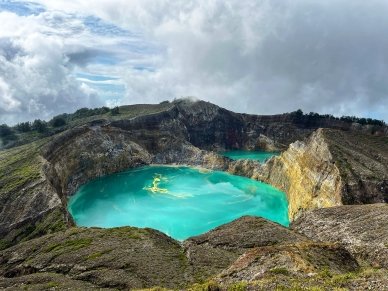
Kelimutu crater lake
The phenomenon has a simple scientific explanation behind it: the minerals that have melted in the lake water. However, the residents of the nearby village have made up their own idea. They believe that there are signs of those who have passed away. Moreover, people have learnt to guess the mood of their souls. The more often colours change, the angrier the souls of the deceased are.
Delight in the beauty of crater lakes having ascended 3 km to the summit or having paid a few rupiahs for a seat in a bemo (local minibus). Though the way is not long, it might be somewhat unpleasant because of the steep mountain spiral highway.
You may take selfies and feast eyes with the lakes to your heart’s content but never swim there. There is a ban on swimming because the mineralised water is a danger to human organisms.
The other volcanic wonder of Indonesia is Ijen in the eastern part of Java. It constitutes an entire complex of stratovolcanoes, craters, and cones.
In one of those 200-metre-deep craters, there is Kawah Ijen, a sulfurous lake surrounded by magnificent waterfalls, hot springs, and bizarre figures of solid lava. Its water is predominantly turquoise, but sometimes it becomes iridescent.
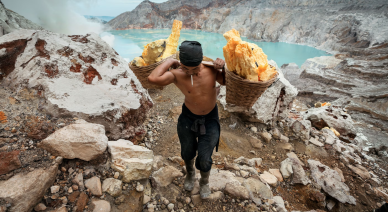
Miner carries a load of sulfur out of the Kawah Ijen crater.
The place itself is incredibly beautiful and even mystic. For decades, this magic has attracted thousands of tourists from all over the world.
The other crater stuns with blue sulfur flames that can be visible only at night.
This marvel also has a scientific background. The temperature in the crater reaches 680 °F, and thus sulfur combusts and produces blue neon flames. Those who are observing this spectacle compare it with the netherworld. In the pitch dark bottom of the caldera, blue lava is radiating among the swirling steam and the smell of sulfur.
Despite Ijen being famous for its unique natural phenomena, this volcano is not totally safe. A lot of things happen here so often, be it the changing colours of the lake waters, the sulfur foam on their surface, or the hundreds of earth shocks.
Local vulcanologists resort to prohibiting visits to the Ijen locality to deter the curious tourists from possible trouble.
Temples
Hindu and Buddhist temples aged more than a thousand years compose a myriad of diamonds in the crown of Indonesia.
Most are in Bali, an island with a record holder of ancient temples (more than 20,000).
However, the two most known are on Java, where almost all residents are adherent to Islam. Prambanan and Borobudur are the monuments of the church architecture that dates back to the early Middle Ages.
Prambanan is an 8th century Hindu temple constructed to praise Brahma, Krishna, and Shiva — the main Hindu gods. It is the largest temple in the world, comprised of hundreds of internal and external constructions. At present, though only eight buildings of each type (16 in total) have remained, they still impress with their high towering spires and the statues of gods.
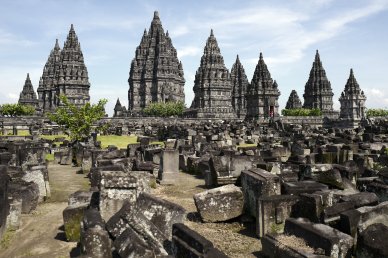
Prambanan temple
Borobudur is a Buddhist temple that was built approximately in the same period as Prambanan.
If to view from above, it becomes visible that its architecture resembles a mandala — a Buddhist symbol of the Universe model made up of circles around squares.
Borobudur history is not only glorious. A tragedy happened in 1006 when the volcanic eruption destroyed the entire temple and covered its area with a thick layer of dust. Residents of the neighbouring villages left the locality, and the temple became forgotten for ages.
The first excavations took place at the beginning of the 19th century, and the capital repairs began a hundred years later. Between the 1970s and the 1980s, all the constructions underwent a complete renovation under the aegis of UNESCO. Since then, Borobudur has been the World Heritage Site.
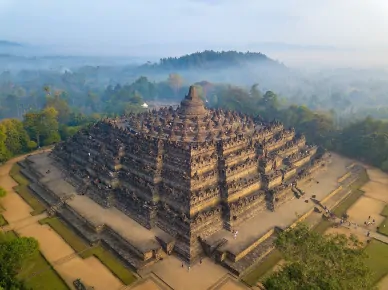
Borobudur temple
Nowadays, this Buddhist temple welcomes millions of pilgrims from all over the globe. Tourists come here to see the Middle Ages monument that has literally risen from the ashes.
Apart from Prambanan and Borobudur, there is a mass of less known but unique temples like Pura Bratan, Tanah Lot, Pura (Luhur) Uluwatu, etc.
National Parks
The nature of Indonesia is a rare phenomenon. Its islands are abundant with animals and birds, and many of them cannot be found anywhere in the world. Even the environment itself has remained the same as it used to be millennia ago.
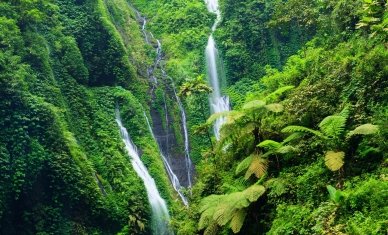
Indonesian rainforest
Rainforests occupy around 70% of the entire Indonesian territory, and the mountain slopes are usually covered with mixed and coniferous forests. The flora is rich in thousands of species of plants, but it may vary by island.
Some of the plants are world-known due to their specific features. For example, there is rafflesia, the world’s largest flower of gorgeous orange-yellow colour.
Rafflesia smells like rotting flesh and thus attracts insects, particularly flies, that die from the pungent odour. What a dazzling but murderous flower!
Any walk across the Indonesian national parks is a feast for the soul. Alas Purwo (Java) astonishes with its lush greenery and bright tropical colors. Gunung Palung (Borneo) is the only place in the world where orangutangs still live in the wild natural habitat. And Lore Lindu National Park (Sulawesi) is home to more than 70 species of rare birds.
One of the most visited places is the Ubud Monkey Forest on the island of Bali. Tourists adore it for an unutterably joyous atmosphere created by the forest inhabitants — Balinese long-tailed macaques.
The saying “a cheeky person owns half a world” could well have its origin in this place. But we mean not people but the happily chattering monkeys. The puzzled tourists are always fondly trying to find and take back from them their accessories, caps, sandwiches, etc.
Being heedless results in losing a cap, a smartphone, or something else that will end up in the hands of a cute macaque.
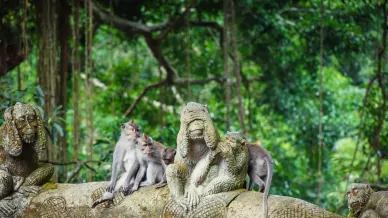
Ubud Monkey Forest
So if you are planning to embark on a tour to Monkey Forest, leave all your accessories and expensive gadgets at home because there have been incidents when the long-tailed petty thieves took out the earrings from the women’s ears. Also do not keep any documents, air flight tickets or some other valuable things in purses, otherwise, you will turn out to be in big trouble.
However, if you are walking without anything that might evoke the monkeys' interest, they will not pay attention to you. They will find the other guests to sponge off.
Diving
The island of Bali is mistakenly considered a luxurious beach resort by those who have never been there.
In reality, that is not actually true: there are only a few astonishing beaches. So why do the tourists come to visit Bali? The answer is very simple — to go diving.
Both skilled divers and inexperienced novices know how to have a wonderful time on the island. The first delight in the beauty of the underwater world and actively shoot the videos or take the photos. The latter persistently learn the basics of correct techniques of diving into the ocean waters. The instructors speak Indonesian, English, and even some other languages.
Diving on Bali is about crystal clear turquoise waters, bizarrely sprawling coral reefs, myriads of fish, jellyfish, and other ocean inhabitants. In Tulamben, located in the northeast of Bali, the diving is particularly engrossing. The interest is aroused by the WWII-wrecked American ship resting in the water not far from the beach.
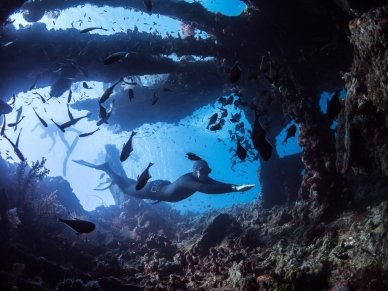
Diving on the sunken World War II battleship USAT Liberty, Bali
This type of entertainment costs $120. Apart from that, taking a photo or shooting a video is $30 - $40 of extra charge. Despite the high cost, stunning captures are a value for money!
Bali attracts divers with safety as well. Divers may descend directly from the coast.
Food
As of any other Asian country, Indonesian cuisine is about much rice and seafood, many vegetables, and less meat. It has undergone the influence of the Chinese, Indian, and Arab cooking traditions because Indonesia was under their control at different times of its history. As a former metropolitan country, even the Netherlands has made a substantial contribution to the variety of Indonesian dishes.
Rice is the number one meal in any house, be it a posh villa of a millionaire or a small hut of a poor. The main difference is in its amount. The poorer the family, the more rice and fewer other products they consume.
The main culinary icon of Indonesia is tumpeng. It is a cone-shaped boiled rice dish with meat, fish, vegetables, shrimp, and other seafood put around it. This food has become extremely popular and much favoured among people. And therefore, the government has given it a status of a national dish. In Indonesia, culinary art is interwoven with philosophy and religious traditions. A high cone of rice symbolizes volcanoes, and the food surrounding it means a tribute to gods.
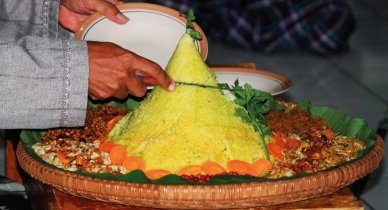
Indonesian tumpeng
Admittedly, for Indonesians, rice is not only an absolute favourite garnish. It frequently serves as bread, for example, when it is necessary to soak off a dip or make a sandwich. However, quite a complicated process is needed to prepare such rice.
So half-boil a portion of glutinous rice and then roll it up in banana leaves. Then place the rolls in a pan to boil for 2-4 hours, adding some water from time to time.
The ready rolls should be cooled down, cut, and served without the leaves. They are pretty thick and easy to dip into the sauce. It is lontong, one of the most popular national dishes of Indonesia.
There is another way of cooking rice. Rectangular and square-shaped rice-packed palm leaves constitute ketupat, which is quite common in many countries of Southeast Asia.
Rice is an ingredient of nasi kucing — the other popular local fast food. It is a small portion of boiled rice with a topping of chicken, vegetables, or seafood, then wrapped in banana leaves.
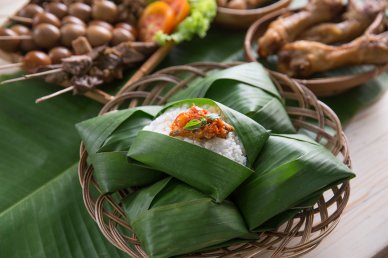
Indonesian local fast food nasi kucing
Nasi goreng is a kind of Indonesian pilaff. Rice should be fried in a pot combined with chicken or other ingredients like seafood, omelet, vegetables, or fish. The dish is filling and very tasty.
The Chinese once demonstrated the Indonesians how to eat noodles, so even nowadays is a good competitor of rice. Indonesian noodles are cooked of rice and wheat flour and then boiled or fried together with meat, vegetables, fish, and seafood. The noodles are also the basis of thick and flavorous soups called laksa.
The third most popular dish is krupuk, a national variation of crackers made of special dough based on rice or wheat flour, starch, dried and powdered vegetables, shrimps, and fish, and then deep-fried in hot oil. As a result, the crackers become larger and more crunchy. They can be dipped in various sauces or eaten without any topping.

Indonesian crackers Krupuk
In Indonesia, they eat many vegetables like tomatoes, cucumbers, onions, aubergines, potatoes, eggplants, cabbage, lettuce, carrots, etc. There are also vegetables of national origin like sweet potatoes and cassava starch.
The vegetables are eaten raw, boiled, fried, and sour. Salads have gained the most popularity, but they differ with the bigger size of pieces. For example, there is gado-gado consisting of raw or boiled vegetables, some green stuff, peanut sauce.
Indonesians do not eat much meat: it is available predominantly for well-off families. They consume chicken and turkey most, less often — pork, which stems from the Islamic traditions. Lamb and goat’s meat are widespread too.
When in a village, you may try some exotic things like the meat of monkeys, dogs, bats, and turtles.
Indonesians include fish in their menus very often. As a rule, they consume boiled, fried, or roasted catfish, carp, or tilapia.
If you want to taste something authentic, pay attention to tempeh — fermented soybeans in a form of a cake. They have a peculiar sour smell and salty taste. Though it may seem not tasty for the majority of Europeans, it is the number one product in this locality.
Due to its high popularity, the residents have called Indonesia the tempeh country.

Authentic Indonesian tempeh dish
Indonesian desserts constitute various kinds of pastry like cookies, pies, or gateaus that may be baked with or without yeast, and with some sweet fillings. There is a general term for those delicacies — kue.
The most favoured drinks on the islands are tea and coffee. Interestingly, green tea is not as popular as black, which is served hot, cold, and even iced with sweet things, lemon slices, or just with sugar.
Teh talua is a local exotic tea, quite strong and with the addition of egg yolk.
Nonetheless, genuine strong tea has become less common since the bottled tea emerged. And therefore, the Indonesians are drinking natural tea less and less.
The second popular drink is coffee, strong and very sweet, sometimes with milk.
Kopi luwak is the legend of Indonesia, the most expensive coffee in the world.
However, the production method may shock even the most eager coffee lover. Just imagine, palm civets are purposefully fed with coffee beans, which gain an unusual taste being affected by ferments and stomach acid. After some time, the animals excrete the beans, and workers prepare them for selling, taking them out of the piles and drying. A kilogram of luwak costs $700, and despite a very extraordinary manufacturing method and exorbitant expensiveness, there are so many of those willing to taste this beverage.
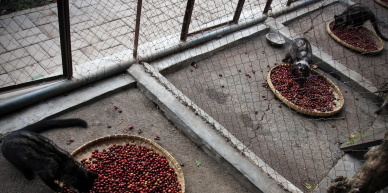
In captivity, civets are fed coffee cherries, the fruit that produces coffee beans.
Due to the increasing popularity of Indonesia as a tourist destination and its dynamic economic development, any bar, restaurant, or shop can offer a wide range of ordinary hard spirits like cognac, whiskey, vodka, martini, and liqueurs.
Some national rice- and palm-based alcoholic beverages known as tuaks are particularly popular in Indonesian towns and villages.
Rice and palm juices get distilled, and after the initial distillation, the drink is 12-15% ABV. However, if there are two or three stages of distillation, it may reach 40-50% ABV.
The national hard spirits are becoming less and less popular in Indonesia. There is a belief that only the poor drink tuaks because they cannot afford to buy a bottle of high-quality liqueur.
Among low-alcohol drinks, locally-brewed or imported beer is the most popular. People consume hard spirits considerably less, which may be explained by the national drinking traditions and the laws of Islam.
The country of volcanoes, temples, and fabulous water world can surprise, astonish, and sometimes even disappoint. Indonesia will convey a distinct indelible impression on everyone who has become lucky to visit it.
FAQ
What is the capital of Indonesia?
The capital of Indonesia is Jakarta.
What is the population of Indonesia?
Indonesia has a population of over 275 million people.
What language is spoken in Indonesia?
The official language of Indonesia is Indonesian (Bahasa Indonesia).
What is the territory of Indonesia?
Indonesia covers a territory of approximately 1.9 million square kilometers.
Is Indonesia a democracy or dictatorship?
Indonesia is a democracy with an elected government and a president as the head of state.
What is the main religion in Indonesia?
The main religion in Indonesia is Islam.
Is Indonesia peaceful?
Indonesia is generally considered peaceful, although there have been regional conflicts and acts of terrorism in the past.
Is Indonesia an island?
Indonesia is an archipelago, consisting of about 18,000 islands.
What is Indonesia known for?
Indonesia is known for its diverse cultures, beautiful landscapes, volcanoes, rich biodiversity, and as the world's largest island country.
Is Indonesia a rich or poor country?
Indonesia is a developing country with a large economy, but it also has significant income inequality and pockets of poverty.
Is Indonesia left or right-hand drive?
Indonesia is a left-hand drive country. Indonesia's practice of driving on the left side of the road is a remnant of its colonial history. The Dutch, who colonized Indonesia, drove on the left and established this convention in the archipelago. After gaining independence, Indonesia retained many of the systems and infrastructures put in place by the Dutch, including left-hand traffic. This is similar to other former British and Dutch colonies that continue to drive on the left.
Do I need a visa to travel to Indonesia?
Visa requirements for Indonesia vary by country. Some nationalities can enter Indonesia without a visa, others can obtain a visa on arrival, and some must apply for a visa before traveling.



